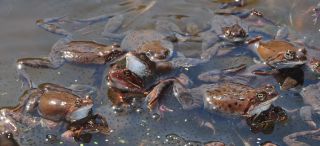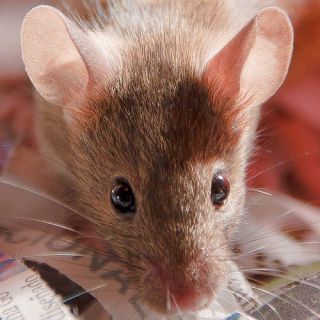Animal Behavior
Deceive to Repel
How female animals outsmart male harassers.
Updated November 19, 2023 Reviewed by Tyler Woods
Key points
- Female animals use a variety of tactics to repel unwanted advancement by males.
- As recently discovered in some dragonflies and frogs, females may feign death to deceive male harassers.
- Female mice produce two chemicals that mimic ferret odors to scare off male harassers.
In the 1994 cinematic blockbuster Disclosure, Tom Sanders, as portrayed by Michael Douglas, becomes ensnared in the clutches of harassment at the hands of his superior, Meredith Johnson, skillfully brought to life by Demi Moore. It is within the confines of this gripping narrative that his attorney, Catherine Alvarez, delivers a line of reverberating resonance: "Sexual harassment is not about sex, it's about power. She has it, you don't."
While this declaration may serve as a dramatic crescendo in the world of cinema, the arena of biology presents an entirely different tableau. Here, the balance of power is usually inverted, with males, rather than females, adopting the role of relentless suitors who may resort to forms of harassment. This biological phenomenon underscores a stark contrast to the power dynamics depicted in the film.
The question that emerges is a profound one: in the absence of legal recourse, how do female animals navigate the complex terrain of unwanted advances from males? Fortuitously, Mother Nature has endowed female creatures with an array of strategies, a testament to the diverse and ingenious ways life has evolved to ensure survival and self-preservation.
In numerous species, females possess the straightforward ability to disengage from unwelcome male suitors by simply moving away. Among social primates like monkeys and apes, a tactical approach akin to recruiting bouncers at a nightclub is employed. In this scenario, females align themselves with higher-ranking males, who serve as protectors and act as deterrents to potential harassers. Also, certain female mammals—such as antelopes, felines, and canines—display remarkable courage by openly confronting and driving away unwanted male advances.
Nonetheless, the pinnacle of innovation in the domain of animal anti-harassment strategies lies in an artful act of deception, as evidenced by recent scientific findings. The moorland hawker dragonfly (Aeshna juncea), as explored in a study conducted by biologist Rassim Khelifa, provides a striking illustration of such maneuvers.

In this species, the males eagerly circle bodies of water, intercepting their female counterparts in midair. However, when the female dragonflies are unresponsive to their advances, they deploy a remarkable ruse—they drop to the ground belly up, simulating death. This artful ploy proves highly effective, given that male dragonflies primarily perceive moving objects. In their state of apparent lifelessness, the females effectively vanish from the males’ vision. Astonishingly, more than 88 percent of female dragonflies resort to this audacious tactic as an escape from male harassment (1).
This “fake death” tactic is also used by certain frog species, such as the brownish common frog (Rana temporaria) in Europe, as recently reported by Carolin Dittrich and Mark-Oliver Rödel.

During the brief window of the mating season, females of this species may find themselves mounted by multiple males, thus increasing the risk of drowning. In response to this predicament, females employ a range of tactics, including emitting stress calls or rotating their bodies to shake off unwanted suitors. For smaller individuals, the preferred tactic involves the simulation of death, effectively duping male harassers into believing their advances have inadvertently led to a tragic outcome (2). This intriguing behavior mirrors a remarkable amphibian rendition of the age-old survival strategy—playing possum.
In the world of cunning and deceptive tactics, look no further than the female mice. While their male counterparts maintain an unrelenting drive for mating, female mice exhibit a far more discerning approach. They reserve their receptivity exclusively for the estrus cycle, and the remainder of the time, they prefer solitude. This raises a compelling question: how do female mice deter persistent male suitors?
The answer to this puzzle eluded us until a fateful day when my colleague, Jianxu Zhang, and I stumbled upon a rather unusual discovery. We detected two distinct chemicals in the urine of female mice, which curiously are also found in the urine of mice’s archenemy, ferrets. This seemingly improbable connection left us pondering how ferret odor had made its way into the world of mice. The moment of epiphany arrived during an unconventional brainstorming session, lubricated by a modest serving of beer during lunch. Could it be that female mice were, in fact, mimicking the scent of ferrets as a clever ploy to deter unwanted male attention?
Our ensuing laboratory experiments provided a resounding answer to this enigma. We introduced these mouse-generated, ferret-scented chemicals to the male mice, and the outcome was nothing short of remarkable: all male mice exhibited fear responses (3). This discovery marked a moment of simultaneous enlightenment and self-reproach. We had been oblivious to the fact that females, even among the seemingly humble species of mice, have the ingenuity to fend off unwelcome advances. It was a revelation, reminiscent of how we use repellent sprays to ward off bears or other predators. Female mice, it seems, have truly mastered the art of “Eau de Ferret.”

References
1. Khelifa, R. (2017). Spatiotemporal Pattern of Phenology across Geographic Gradients in Insects. Ph.D. dissertation, University of Zurich.
2. Dittrich, C. & Rödel, M-O. (2023). Drop dead! Female mate avoidance in an explosively breeding frog. R. Soc. Open Sci. 10: 230742.
3. Zhang, J., Sun, L. & Novotny, M. (2007). Mice respond differently to urine and its major volatile constituents from male and female ferrets. J. Chem. Ecol. 33: 603 – 612.




